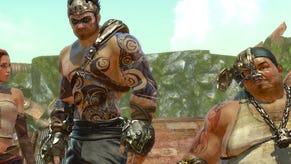Face-Off: Enslaved: Odyssey to the West
Complete analysis of Ninja Theory's Unreal adventure.
Translated into the gameplay, the gap appears to narrow. There is still a clear sensation of smoother action and higher image consistency with the 360 build in the general flow of the action, but there's no doubt that when the going gets tough, both games can judder and drops frames badly. You can see it in the following analysis video, which takes five different scenes from across a range of chapters covering everything from general combat to terrain traversal and commandeering a turret.
On the one hand, it's clear that Ninja Theory is doing things with Unreal Engine 3 that few developers have tried before: the scale of the levels and the overall intricacy in the visuals is at times hugely impressive. On the other hand, the performance drops definitely impact the overall sheen on the presentation at many junctures. Xbox 360 is ahead by a nose at this point, but you can't help but wish for superior performance on both platforms.
The vast size of the levels in Enslaved is an interesting and unique workout for the Unreal Engine 3 technology and both versions of the game can be found wanting in different respects. Xbox 360 may well enjoy a smoother experience overall relatively speaking, but there's no doubt that the texture streaming technology is pushed beyond breaking point at times and in this respect PS3 has a small advantage.
This manifests in two different ways. In scene transitions you can often see textures building up, and for artwork that is front and centre in the screen this is visually quite disconcerting. This effect is actually down to a piece of tech that hails from UE3 additions made during the Gears of War 2 era, where blended mip-maps are used to stop textures literally popping into view from nowhere as seen in the often rough-looking Mass Effect 1. However, the transition is either much faster or almost completely absent in the same areas on PlayStation 3.
Also curious is that this is not a problem of not being able to stream in data quickly enough from the DVD: we know this because a full installation to the Xbox 360 hard drive does nothing to improve matters in any way whatsoever.
What we do know about UE3 titles on the PS3 is that they can operate with a dynamic HDD install. The game asks you for a set amount of space on the HDD on launch. This can be mandatory or optional depending on developer choice, though you get a warning of lower performance if you choose to disable the feature. Enslaved's background install is mandatory, but doesn't interrupt gameplay, so perhaps this is the element that makes the difference?
Enslaved is also somewhat bizarre in that the game occasionally stops in arbitrary sections to load in additional data - very reminiscent of the original Mass Effect where the same thing occurred if the background streaming couldn't keep up with the player's progress through the level. Now the odd thing here is that there are sections where both platforms will pause to gather more data, but then there are times when only the 360 appears to hesitate - in these latter cases, the HDD install does appear to solve the problem, and it seems to help improve loading times in general.
Here's a video to demonstrate all of this. Firstly there's a collection of texture mip-map blending transitions featuring the 360 game running from both hard drive and DVD, then the PlayStation 3 version. There's a variety of clips here, the first example probably being one of the worst in the whole game. After that we've isolated impromptu loading that only occurs with 360 running from DVD, then a clip showing it happening on 360 DVD, HDD and PS3.
It's worth putting these differences into context - impromptu loading only happens once or twice per chapter, if that, and as the video demonstrates, the difference in the texture "popping" varies on a case by case basis. Nobody is likely to be unduly upset with performance in this regard, although there are undoubtedly some fairly fugly examples of texture transitioning on 360 that are difficult to ignore; at least when it happens on PS3, it's over pretty quickly. A key mitigating factor here is that it only happens on certain scene transitions, typically during cut-scenes or when moving from cinematic to gameplay, so it should be emphasised that the effect is nowhere near as detrimental as it was in Mass Effect, where the artifacts were frequently part and parcel of the in-game experience.
In the final analysis, it's evident that both Xbox 360 and PS3 renditions of Enslaved have their own particular strengths, weaknesses and individual quirks. The implementation of the background streaming on PS3 clearly helps out a game like this: there are demonstrable advantages to the data streaming that are only partially matched on 360 when the game is installed on to the hard drive.
For its part, the Xbox 360 has its own plus points - generally higher frame-rates, lower levels of screen-tear, and a minor range of subtle graphical boosts. You also get Dolby Digital 5.1 as standard with the 360 version - oddly, the PS3 game only supports uncompressed LPCM 5.1 over the HDMI port, so no surround sound if you have your console attached to the amp with Toslink. Bizarre, frankly.
None of the disadvantages of either version are real game-breakers and overall either version is recommended, but if you own both consoles and have the choice of which version to buy, the Xbox 360 release is the one to get: a generally higher level of performance must surely take precedence over the occasional streaming problem.













